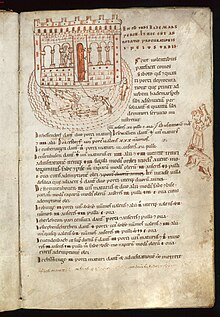
The Codex Falkensteinensis (also referred to as Codex diplomaticus Falkensteinensis or Liber traditionum comitatus Neuenburg-Falkenstein) is an important medieval manuscript. It was written in 1166 as a feud directory and urbarium by Canons of the Herrenchiemsee monastery, commissioned by the Counts of Neuburg-Falkenstein. Composed at the Neuburg castle near Vagen it is considered the only preserved secular codex from the Hohenstaufen era, the oldest extant book of conveyances from a secular lordship and the oldest European family archive. The original Latin version is preserved in the archives of the Bavarian state, a second Middle High German edition is lost.
Historical and legal significance
The Codex Falkensteinensis, written in medieval Latin, lists possessions and estates of the Counts of Falkenstein, covering a large area between the Bavarian Mangfall valley, today's South Tyrol and Lower Austria, in addition to the dynasty's core countries in the Inn and Vils valleys. Intending to take part in Friedrich Barbarossa's fourth Italian expedition, Siboto IV ordered to draft the manuscript, with the aim to secure the property situation for his under-age children, should he perish during the campaign.
Originally, a second edition was written in German, in addition to the Latin version. It was cited by several historic authors, but was lost towards the end of the 17th century.
The oldest part of the Codex Falkensteinensis includes provisions for the guardianship of the count's children and a directory of fiefs and allodial property of the Falkenstein lineage. Later additions that were added until about 1193 contain legal and historical notes and lists of revenue and harvest.
Notably, the codex also includes recordings of an ecclesial penance, a medieval medicinal formula and a hint to a solar eclipse in 1133.
A unique feature of the manuscript is that it contained the copy of a clandestine letter of Siboto IV to his lower-Austrian vassal Ortwin von Merkenstein, in which he ordered to eliminate his enemy Rudolf von Piesting. It remains unclear if Siboto ordered a murder or blinding, or if the letter is forgery in order to disparage Siboto. An additional option is that the letter was written but kept by Siboto in order to use it as leverage towards his lower-Austrian relatives.
Artistic aspects
The Codex diplomaticus Falkensteinensis is richly endowed with illustrations and miniatures that are influenced by the transition from byzantine art to European medieval illumination.
The first pages of the manuscript are illustrated with a pictorial representation of the count's family, showing Siboto IV, his wife Hildegard von Mödling and his sons Kuno and Siboto V. This illustration is considered to be one of the oldest family portraits. Four additional miniatures depict the major castles of the lineage, the Neuburg castle, the Falkenstein castle, Hartmannsberg and Hernstein. Other illustrations portray animals and farmers.
Further reading
- K. Weidemann: Hof, Burg und Stadt im östlichen Oberbayern während des frühen und hohen Mittelalters. In: Römisch-Germanisches Zentralmuseum Mainz (Hrsg.): Führer zu vor- und frühgeschichtlichen Denkmälern. Band 18: Miesbach, Tegernsee, Bad Tölz, Wolfratshausen, Bad Aibling. Verlag Philipp von Zabern, Mainz am Rhein 1971.
- Elisabeth Noichl: Codex Falkensteinensis. Die Rechtsaufzeichnungen der Grafen von Falkenstein. Beck, München 1978, ISBN 3-406-10388-X, (Quellen und Erörterungen zur bayerischen Geschichte N. F. 29).
- J. B. Freed, The Counts of Falkenstein: Noble Self-Consciousness in Twelfth-Century Germany. The American Philosophical Society, Philadelphia 1984; ISBN 0-87169-746-7
- Werner Rösener: Codex Falkensteinensis. Zur Erinnerungskultur eines Adelsgeschlechts im Hochmittelalter. In: Werner Rösener: (Hrsg.): Adelige und bürgerliche Erinnerungskulturen des Spätmittelalters und der Frühen Neuzeit. Vandenhoeck & Ruprecht, Göttingen 2000, ISBN 3-525-35427-4, (Formen der Erinnerung 8), S. 35–55.
External links
- Online version of the Codex Falkensteinensis (KL Weyarn 1) and of Elisabeth Noichl's edition by the Bavarian State Library
- Digital version of the Codex Falkensteinensis in the cultural portal bavarikon
- Summary by the University of Klagenfurt
References
- ^ Freed, John B. (January 2004). "Bavarian Wine and Woolless Sheep: The Urbar of Count Sigiboto IV of Falkenstein (1126–ca. 1198)". Viator. 35: 71–112. doi:10.1484/J.VIATOR.2.300193.
- Freed, John B. (January 2006). "The Creation of the Codex Falkensteinensis (1166): Self-Representation and Reality". Representations of Power in Medieval Germany. International Medieval Research. 16: 189–210. doi:10.1484/M.IMR-EB.3.3440. ISBN 978-2-503-51815-2.
- ^ Peter Bergmaier (1966): Codex diplomaticus Falkensteinensis, deutsche Übersetzung. Der Mangfallgau 11: 5–68
- Elisabeth Noichl: "Codex Falkensteinensis – Die Rechtsaufzeichnungen der Grafen von Falkenstein". C. H. Beck'sche Verlagsbuchhandlung, München, 1978. ISBN 340610388X
- Patrick J. Geary, John B. Freed (2008). Literacy and Violence in Twelfth-Century Bavaria: The "Murder Letter" of Count Siboto IV. Viator 25, 115-130. doi:10.1484/J.VIATOR.2.301210
- Hans Petz, Hermann von Grauert und Johannes Mayerhofer: Drei bayerische Traditionsbücher aus dem XII. Jahrhundert: Festschrift zum 700jährigen Jubiläum der Wittelsbacher Thronbesteigung. Verlag von Max Kellerer, München 1880
